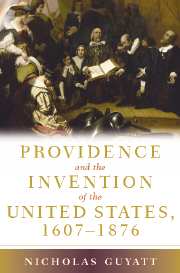Book contents
- Frontmatter
- Contents
- Acknowledgments
- Introduction
- PART ONE BRITAIN, AMERICA, AND THE EMERGENCE OF PROVIDENTIAL SEPARATISM
- PART TWO PROVIDENCE, RACE, AND THE LIMITS OF REVOLUTION
- 4 “Our Glorious Example”: The Limits of Revolutionary Providentialism
- 5 “Deifying Prejudice”: Race and Removal in the Early Republic
- 6 “Divided Destinies”: The Providential Meanings of American Slavery
- 7 “The Regenerated Nation”: The Civil War and the Price of Reunion
- 8 William Lloyd Garrison's Complaint
- Index
7 - “The Regenerated Nation”: The Civil War and the Price of Reunion
Published online by Cambridge University Press: 12 December 2009
- Frontmatter
- Contents
- Acknowledgments
- Introduction
- PART ONE BRITAIN, AMERICA, AND THE EMERGENCE OF PROVIDENTIAL SEPARATISM
- PART TWO PROVIDENCE, RACE, AND THE LIMITS OF REVOLUTION
- 4 “Our Glorious Example”: The Limits of Revolutionary Providentialism
- 5 “Deifying Prejudice”: Race and Removal in the Early Republic
- 6 “Divided Destinies”: The Providential Meanings of American Slavery
- 7 “The Regenerated Nation”: The Civil War and the Price of Reunion
- 8 William Lloyd Garrison's Complaint
- Index
Summary
On January 12, 1861, Senator William Seward of New York pleaded with his southern colleagues to remain in the Union. South Carolina had passed its secession ordinance in December; in the two days before Seward's speech, Alabama, Florida, and Mississippi had followed suit, though their representatives in the U.S. Congress continued to attend the fraught debates as the capital waited for Abraham Lincoln's arrival. “I feel sure that the hour has not come for this great nation to fall,” ventured Seward on the Senate floor. “This Union has not yet accomplished what good for mankind was manifestly designed by Him who appoints the seasons.” Seward, like the editors of Harper's New Monthly Magazine or the despairing Robert Winthrop, hoped that the providential mission of the United States would keep the South in the Union. If God had truly ordained a great destiny for America, then the Union could survive even the treason of a few determined separatists: “No, sir,” Seward added, “if we were cast down by faction to-day, it would rise again and reappear in all its majestic proportions tomorrow.” The senators from Alabama, Florida, and Mississippi, evidently unmoved by this, rose themselves nine days later to make their valedictory addresses to Congress. On the morning of January 21, led by Jefferson Davis, they swept out of the chamber leaving behind a silence that was broken only by gasps and scattered applause. The Union had been dissolved with little regard for its history or for its grand future.
- Type
- Chapter
- Information
- Providence and the Invention of the United States, 1607–1876 , pp. 259 - 298Publisher: Cambridge University PressPrint publication year: 2007



